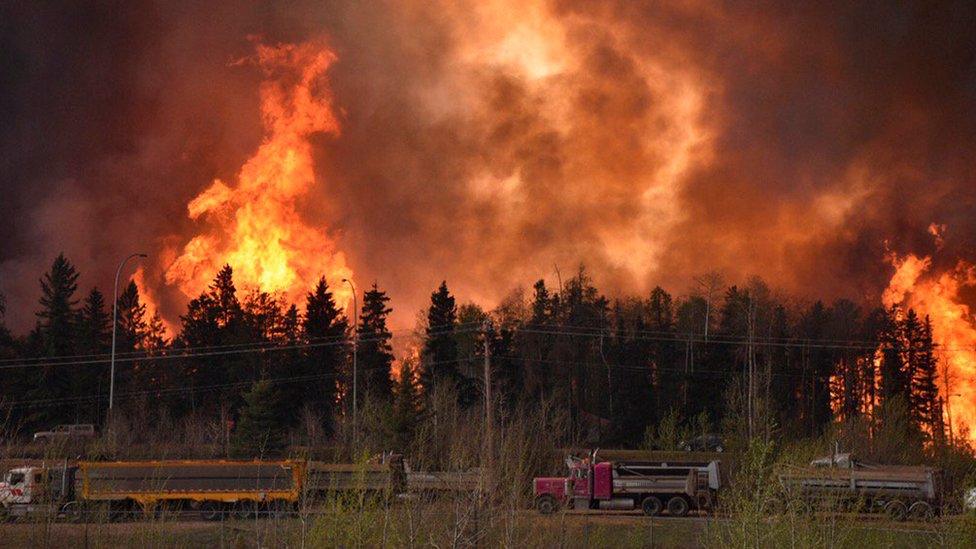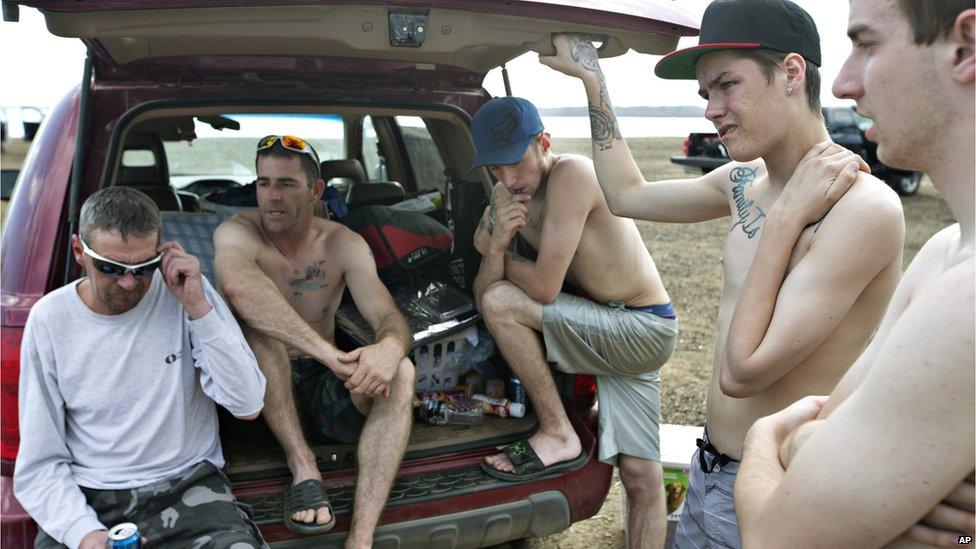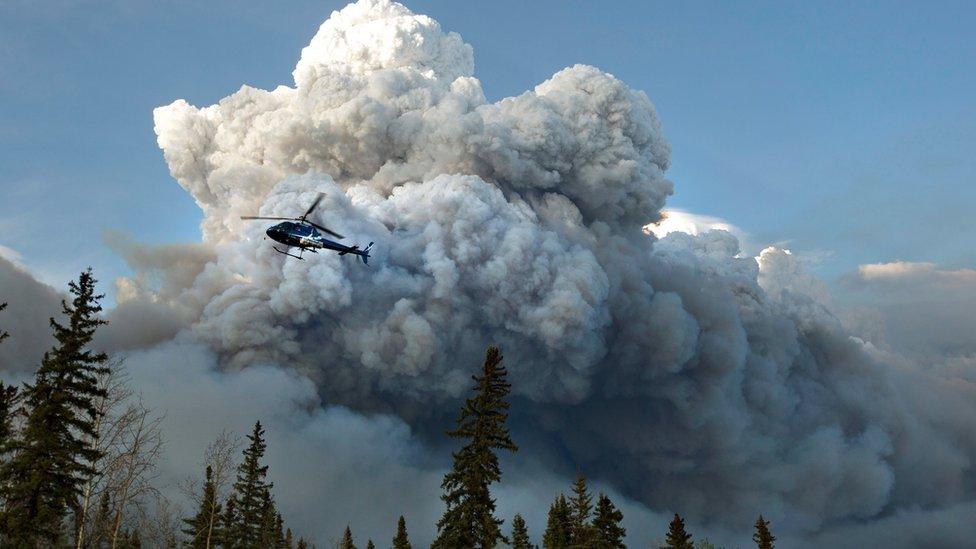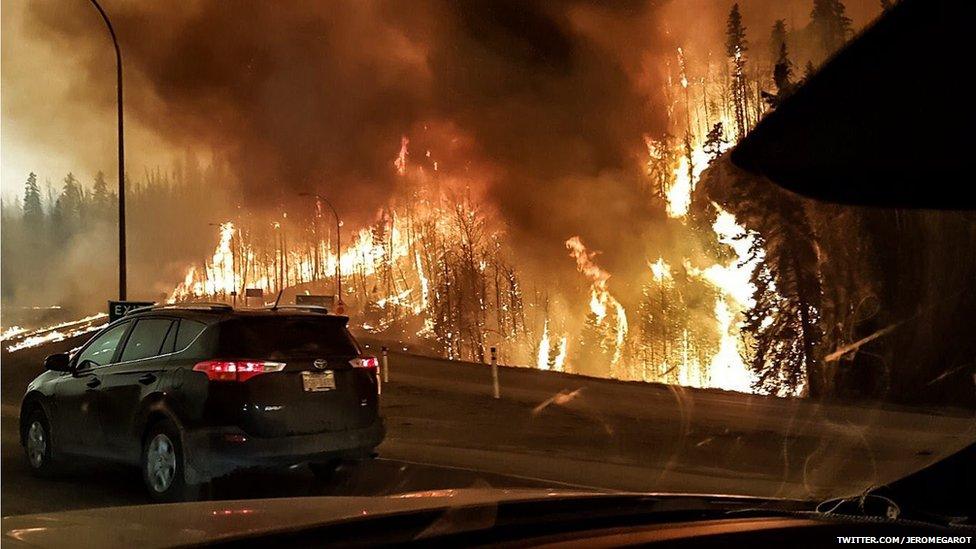Wildfires: Why they start and how they can be stopped
- Published

A state of emergency has been declared in Alberta in Canada after a wildfire forced all 88,000 residents of Fort McMurray to be evacuated.
Officials warn that the fast-moving blaze could destroy large parts of the oil-rich city.
The fire, which broke out on Sunday, has gutted 1,600 buildings, including a new school.
That would be like everyone living in Grimsby having to leave their homes.

How do wildfires start?
A fire needs three things: fuel, oxygen and heat. Firefighters often talk about the fire triangle when they're trying to put out a blaze.
The idea is that if they can take away any one of those elements they can control and ultimately extinguish the fire.
On a hot summer's day when drought conditions peak, something as small as a spark from a train wheel striking the track can ignite a raging wildfire. Sometimes, fires occur naturally, ignited by heat from the sun or a lightning strike.
However, the majority of wildfires are the result of human carelessness. Causes include arson, campfires, discarding lit cigarettes, not burning debris properly, playing with matches or fireworks.
As yet, we don't know how the fires in Alberta started.

Topless and homeless, they spent the night in their van after being evacuated from their homes
Why can they spread so quickly?
Once it's started a wildfire can be wind driven, slope driven or fuel driven.
When all these three come together it can be very extreme turning into a raging blaze that scorches thousands of acres just like in Alberta.
"Where a slope is going upwards at a 10% gradient that would double the speed of the fire, if it's 20% it would quadruple the speed of the fire," Rob Gazzard, technical advisor to the Forestry Commission tells Newsbeat.
An entire city on the run
"That's because it's pre-heating the fuel above it. So if a fire is going up a mountain it will go very fast."
Fuel includes everything from trees, underbrush and dry grassy fields to homes. The more fuel there is, the more intensely the fire will burn causing it to spread faster.
Plus if it's really dry - like it has been in Alberta - the fire it creates is much more difficult to contain.
What's the weather got it do with it
Quite a lot actually.
Low rainfall causing a drought, searing hot temperatures and wind all make the perfect recipe for a wildfire.
Remember the heat in the fire triangle? The sticks, trees and underbrush on the ground get hot from the sun, then very dry. As it gets even hotter those "fuels" can ignite and that's why wildfires tend to rage in the afternoon, when temperatures are at their hottest.
A wildfire can create its own weather

That massive cloud is called a pyrocumulonimbus
"Fires need fuel and they need oxygen to survive," says Rob.
"They hunt down the two and in extreme circumstances can create their own atmospheric conditions. A pyrocumulonimbus cloud is formed when heat rises from a wildfire."
He was in America last year fighting a wildfire in Oregon which spanned 104,000 acres.
"It was very smoky, with lots of fast winds. It was difficult to orientate yourself and very challenging."
How to 'win' the fire
"You have to remove the fuel because you can't affect the weather or topology.
"Using wildfire prediction tools which look at the aspect of the slope, wind speed and direction and the topology - so the uphill, downhill - and the fuel we work out where we can win the fire.
"So that would be downhill, out of the sun, where fuel is low and where wind plays less of a role.
"You go hours or days ahead of the fire and remove anything that can fuel it using bulldozers, tree harvesters, hand tools. You then create a fuel break [basically a big trench] around the whole of the fire. Then you can win and suppress it really effectively."

It can happen in the UK too
"We tend to get them in England and Wales, as well as part of Northern Ireland and Scotland near urban and rural areas. Fires here are generally smaller because our temperatures aren't as extreme as Australia, New Zealand, South Africa, Canada or United States.
"According to the government's climate change risk assessment wildfires are predicted to increase in the United Kingdom by 30-50% by 2080."
There is even a practice guide, external on preventing wildfires in the UK.
This involves picking less flammable trees, planting them in places where they're less likely to set on fire and harvesting them regularly.
Find us on Instagram at BBCNewsbeat, external and follow us on Snapchat, search for bbc_newsbeat